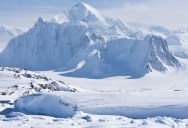Here’s Why Antarctica 5,500,000 Square Miles Is Considered A Desert

It seems odd to think that this vast expanse of cold, ice, and snow could actually be a desert.
That said, scientists promise us that’s exactly what Antarctica is.
Deserts are defined as landscapes where little precipitation occurs – typically less than 10 inches of rain or snow per year – and Antarctica meets that criteria.
The average amount of precipitation over the continent is estimated to be under 6 inches per year.
Some of the coastal regions receive downpours of snow occasionally, but the interior of the continent sees a few centimeters or less.
Other aras, like McMurdo Dry Valleys, haven’t received a single drop of any moisture for literally millions of years.

Some doubt the veracity of these claims, but they are without a doubt one of the driest places on Earth.
At over 5,500,000 square miles, it’s also easily the largest desert in the world.
The reason it’s so dry is mostly because it’s so cold. Cold air holds less moisture than warm air, making it difficult for clouds to form.
This is why more clouds and precipitation happen near the coast.
Scientists who work there claim potato chips and popcorn never go stale in the dry air. There’s no mildew or mold, and you don’t have to dry your hair after a shower.
Dehydration is a major hazard for those who stay there, even for a short period of time. Your skin and nasal cavities will also take a hit.
British army officer Henry Worsley attempted to become the first person to cross the continent alone and unaided in 2016.
He ended up dying after being overcome by exhaustion and severe dehydration after 71 days.

He was 30 miles short of his goal.
It’s a formidable place, but if you think about it like a desert, all of these dangers make sense.
You might not run into scary wildlife or sweat to death like you would trying to cross the Sahara, but it’s just as daunting a landscape.
If you thought that was interesting, you might like to read a story that reveals Earth’s priciest precious metal isn’t gold or platinum and costs over $10,000 an ounce!

Sign up to get our BEST stories of the week straight to your inbox.




